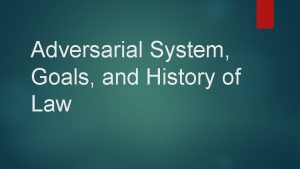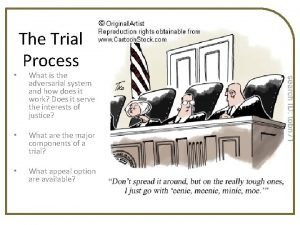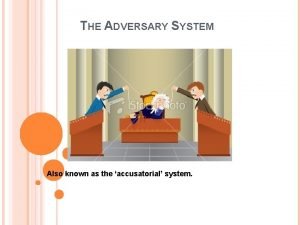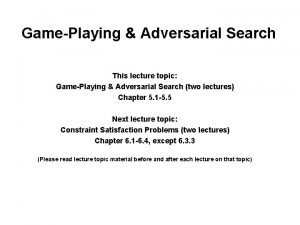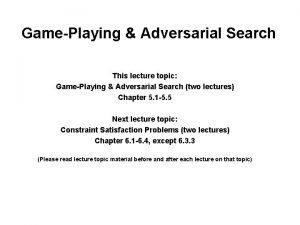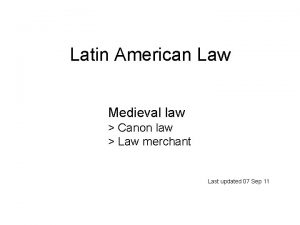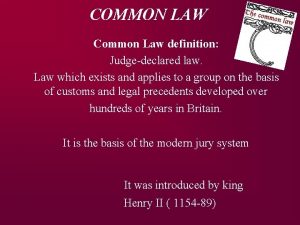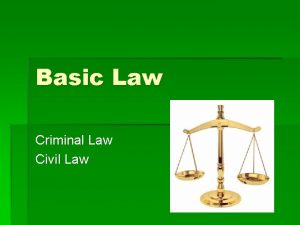Adversarial System Goals and History of Law Adversarial














- Slides: 14

Adversarial System, Goals, and History of Law

Adversarial System Definition: a legal system used in the common law countries where two advocates represent their parties' case or position before an impartial person or group of people, usually a jury or judge, who attempt to determine the truth and pass judgment accordingly. Traced back to medieval times of Trial by Combat

Goals of the Criminal Justice System Offender rehabilitation What does this mean? What would this might look like? Offender punishment What types of punishment could there be for felonies and misdemeanors? Victim Restoration What are types of restoration? Community Safety

History of Law: Hammurabi’s Code The Code of Hammurabi is a well-preserved Babylonian law code of ancient Mesopotamia, dating back to about 1754 BC (Middle Chronology). It is one of the oldest deciphered writings of significant length in the world. The code consists of 282 laws, with scaled punishments, adjusting "an eye for an eye, a tooth for a tooth as graded depending on social status, of slave versus free man. Half of the code deals with matters of contract, establishing the wages to be paid to an ox driver or a surgeon.

Hammurabi’s Code Cont. Other provisions set the terms of a transaction, establishing the liability of a builder for a house that collapses, or property that is damaged while left in the care of another. 1/3 of the code addresses issues concerning household and family relationships such as inheritance, divorce, and paternity The code was discovered by modern archaeologists in 1901, and its translation published in 1902 by Jean-Vincent Scheil.


Roman law Definition: The legal system of ancient Rome, including Roman Military Jurisdiction and the legal developments spanning over a thousand years of jurisprudence, from the Twelve Tables (c. 449 BC), to the Corpus Juris Civilis (AD 529) ordered by Eastern Roman Emperor Justinian I. Roman Law influences Common Law

Roman Law Cont. Roman law thus served as a basis for legal practice throughout Western continental Europe, as well as in most former colonies of these European nations, including Latin America, and also in Ethiopia The first legal text is the Law of the Twelve Tables, dating from the mid-5 th century BC


Magna Carta Definition: Charter of English liberties granted by King John on June 15, 1215, under threat of civil war and reissued with alterations in 1216, 1217, and 1225. Foundation for the English system of common law. It is the first written constitution in European history.

Magna Carta Cont. Of its 63 clauses, many concerned the various property rights of barons and other powerful citizens, suggesting the limited intentions of the framers. The benefits of the charter were for centuries reserved for only the elite classes, while the majority of English citizens still lacked a voice in government.


Activity In groups of 2 research one of the ancient codes and create a web map of the following The importance of it Who was involved in the writing of it What part of the codes influenced US Law/ the Criminal Justice System Fun facts about it

Review Crime Control Model: Emphasizes collective needs that all offenders should receive the harshest penalty allowed by law. // Theory of criminal justice which places emphasis on reducing the crime in society through increased police and prosecutorial powers. Due Process Model A model of the criminal justice system that assumes freedom is so important that every effort must be made to endure that criminal justice decisions are based on reliable information; it emphasizes the adversarial process, the rights of defendants, and formal decision-making procedures.
 Strategic goals tactical goals operational goals
Strategic goals tactical goals operational goals Strategic goals tactical goals operational goals
Strategic goals tactical goals operational goals Adversarial system law definition
Adversarial system law definition Newton's first law and second law and third law
Newton's first law and second law and third law Newton's first law
Newton's first law General goals and specific goals
General goals and specific goals Motivation in consumer behaviour
Motivation in consumer behaviour Adversial system
Adversial system Adversary system
Adversary system V=k/p
V=k/p Boyle's law charles law avogadro's law
Boyle's law charles law avogadro's law Adversarial stakeholders
Adversarial stakeholders Adversarial personalized ranking for recommendation
Adversarial personalized ranking for recommendation Pgd
Pgd Quantum generative adversarial learning
Quantum generative adversarial learning


